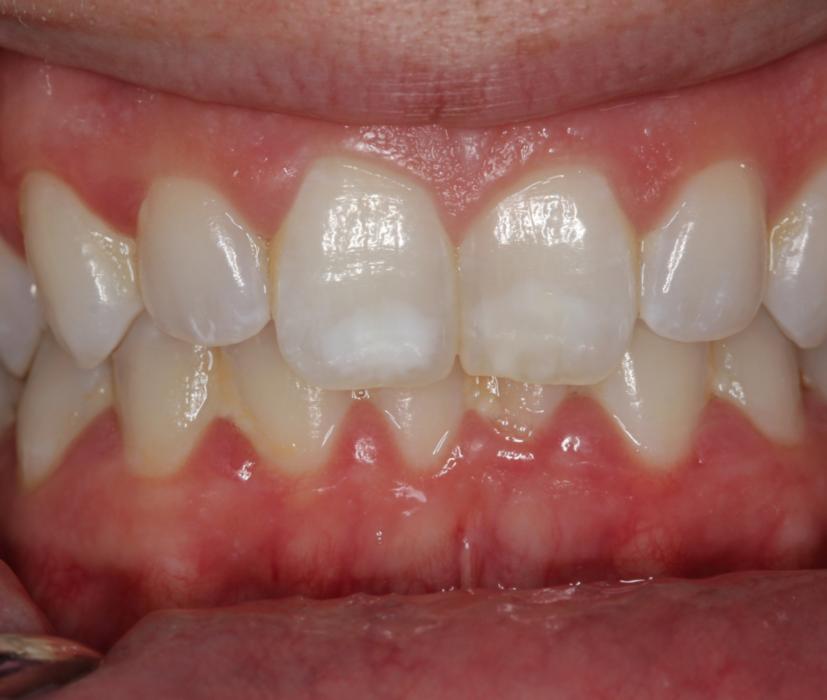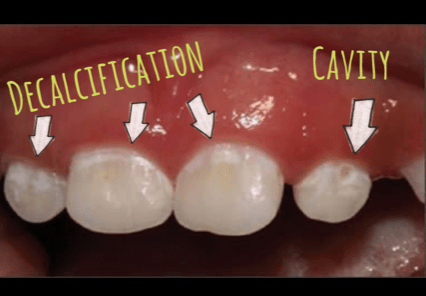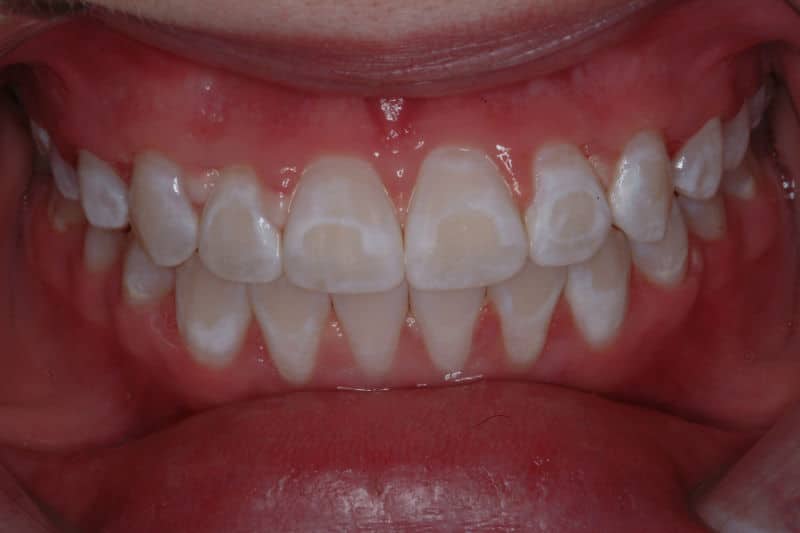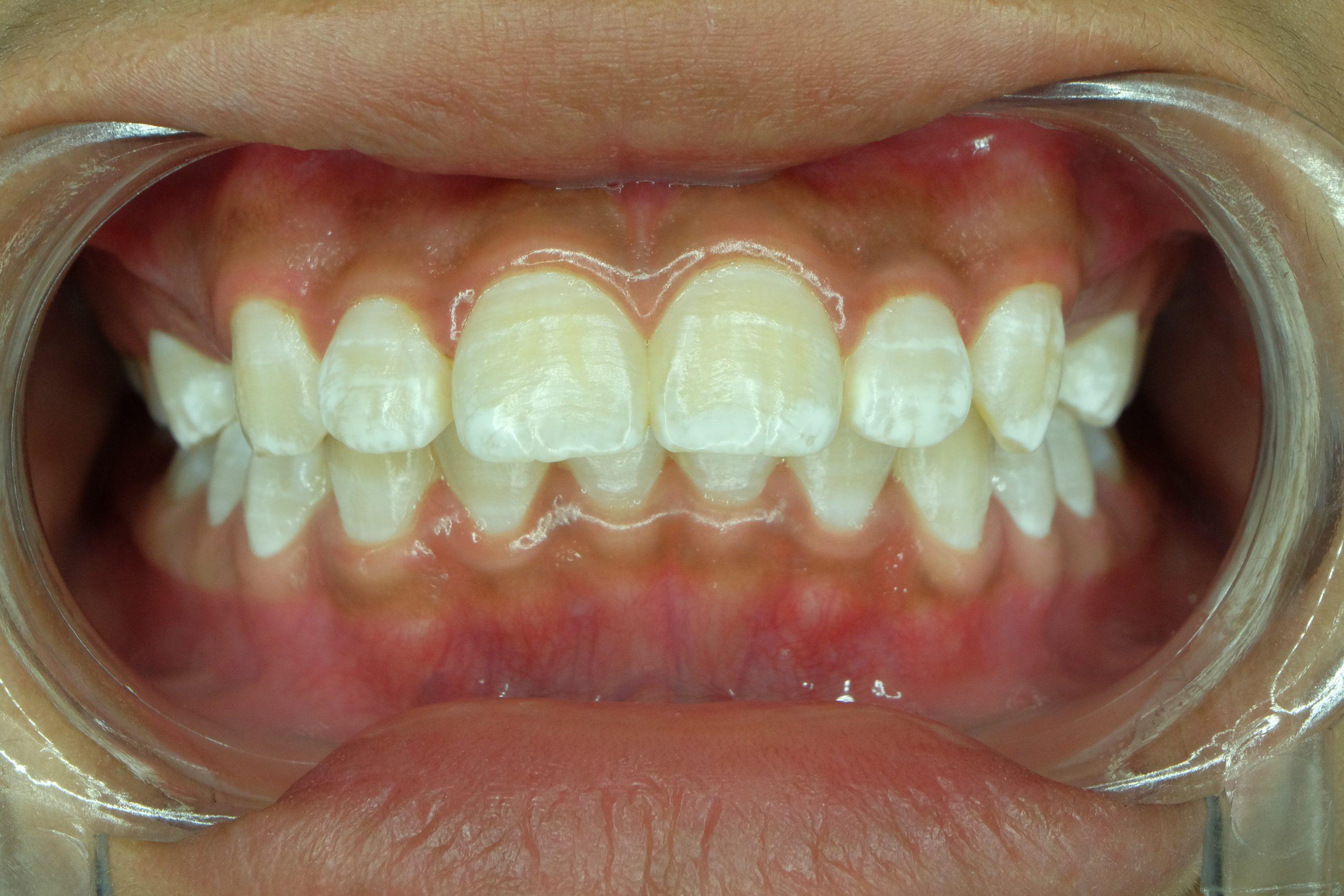Disclosure :: This post is sponsored by Lafayette Pediatric Dentistry and authored by local mom & dentist, Dr. Anita Gouri. Even if discolored teeth is NOT an issue in your home, Dr. Gouri highly recommends that you consider seeing a pediatric dentist by age one. If you would like to read more about the most common causes of teeth discoloration click HERE.
Why Does My Child Have White Spots On Their Teeth?
On any given day in my office, I see these on several patients, several times a day: WHITE SPOTS. They are extremely common, but varied in origin, level of concern, and type of treatment.
Here’s a breakdown on white lesions in tooth enamel:
Congenital blemishes. With these white spots, most parents/patients say “the tooth came out looking like this.” That’s because the spot was created while the tooth was still forming. Some type of disturbance occurred during the development of the tooth, such as illness or trauma to the baby tooth before it, causing this little spot to form as the tooth was calcifying. Most of the time the disturbance is unknown. The good news is that this type of white spot is harmless to the tooth, and is more like a freckle or birthmark. It is also treatable if it appears unsightly to the patient or parent.
forming. Some type of disturbance occurred during the development of the tooth, such as illness or trauma to the baby tooth before it, causing this little spot to form as the tooth was calcifying. Most of the time the disturbance is unknown. The good news is that this type of white spot is harmless to the tooth, and is more like a freckle or birthmark. It is also treatable if it appears unsightly to the patient or parent.
There are many ways to treat these areas, based on the depth of the lesion. Most can be masked by infiltrating the spot with a resin material that matches the unblemished part of the tooth. A good consult and exam can determine what’s best.
Decalcification. These white spots are more worrisome, because they weaken the tooth and are precursors to cavities. They are usually caused by poor oral hygiene. A common  place they occur is right along the gum line, an area where children often miss while brushing and where plaque accumulates easily. Dry mouth, which can be caused by certain medical conditions or medications, can make your teeth more prone to decalcification. Your saliva protects and hydrates your teeth, and helps buffer the pH of your mouth against acids. It is therefore important to prevent dry mouth as much as possible.
place they occur is right along the gum line, an area where children often miss while brushing and where plaque accumulates easily. Dry mouth, which can be caused by certain medical conditions or medications, can make your teeth more prone to decalcification. Your saliva protects and hydrates your teeth, and helps buffer the pH of your mouth against acids. It is therefore important to prevent dry mouth as much as possible.
Fortunately, there are some minimally invasive treatments available to help re-mineralize these lesions if caught early enough and if home care improves. There are calcium-fortified toothpastes available through your dentist that can diminish or reverse the appearance of these white spots when used properly and in a timely manner. We offer MI Paste™ at our practice for this purpose. If not caught early enough, more involved cosmetic work with fillings may be indicated.
Orthodontic white spots. These frequently appear during treatment with traditional braces and are also caused by decalcification as a result of poor oral hygiene. Brackets and wires make cleansing the teeth more difficult, and often brushing and flossing are not  thoroughly performed. Little rectangular-shaped decalcified spots around where the brackets were, along the gum line, and in between the teeth can start to form as a result. Ensuring you get regular dental checkups during orthodontic treatment is crucial for catching these white spots early and hopefully treating them less invasively. Many patients mistakenly think that going to an orthodontist for regular adjustments also qualifies as a periodic dental checkup. It does not. While orthodontists often catch carious or decalcified lesions at adjustment appointments, they are not doing the thorough exams and cleanings that your pediatric dental office performs every six months.
thoroughly performed. Little rectangular-shaped decalcified spots around where the brackets were, along the gum line, and in between the teeth can start to form as a result. Ensuring you get regular dental checkups during orthodontic treatment is crucial for catching these white spots early and hopefully treating them less invasively. Many patients mistakenly think that going to an orthodontist for regular adjustments also qualifies as a periodic dental checkup. It does not. While orthodontists often catch carious or decalcified lesions at adjustment appointments, they are not doing the thorough exams and cleanings that your pediatric dental office performs every six months.
Treatment for orthodontic white spots, when caught early, can be re-mineralized with MI Paste™. When caught later, restoration can be more challenging and may involve more specific cosmetic dental work.
Dry mouth. Teeth that are dehydrated often appear white and chalky on the entire surface of the tooth. This is most commonly seen when you wake up in the morning after you’ve been sleeping with your mouth open. Fortunately, the whiteness disappears once you close your mouth and saliva is allowed to rehydrate the tooth. It is important to note, however, that chronic mouth breathing (and therefore frequent dehydration of your teeth) increases your risk of cavities and should be corrected. Common causes of chronic mouth breathing include untreated conditions like: allergies, narrow jaws/nasal cavity, tongue tie, enlarged tonsils/adenoids, certain medical conditions, and sleep apnea.
Fluorosis. These white spots are the most difficult to treat. They are not just on the surface of the tooth but deep within the layers of the tooth. They occur when a child  ingests too much fluoride. It is important to check with your dentist to see if there is fluoride in your child’s drinking water and to not take systemic fluoride vitamins if there is. The same rule applies if your child is still too young to spit out fluoridated toothpaste. There is also no federal requirement to state whether fluoridated water is used in processed bottled beverages like juice and sports drinks, so fluoride can be consumed unknowingly in so many ways. Because fluoride is very beneficial for healthy teeth and cavity prevention, however, we still recommend its topical use. Our office suggests using only a small amount of fluoride toothpaste at home twice a day and topical fluoride application in the dental office during 6 month checkups.
ingests too much fluoride. It is important to check with your dentist to see if there is fluoride in your child’s drinking water and to not take systemic fluoride vitamins if there is. The same rule applies if your child is still too young to spit out fluoridated toothpaste. There is also no federal requirement to state whether fluoridated water is used in processed bottled beverages like juice and sports drinks, so fluoride can be consumed unknowingly in so many ways. Because fluoride is very beneficial for healthy teeth and cavity prevention, however, we still recommend its topical use. Our office suggests using only a small amount of fluoride toothpaste at home twice a day and topical fluoride application in the dental office during 6 month checkups.
Treatment of white spots caused by fluorosis usually involves more extensive cosmetic work like crowns or veneers, as there is no surface treatment or toothpaste that can improve the appearance here.
If you think your child has any of these white spots, it can certainly be challenging to determine what type of lesion it is. We can help you! Call us for a consultation. 337-443-9944.
For more information on Lafayette Pediatric Dentistry or Dr. Anita Gouri visit the links below OR call the office at (337) 443-9944 and set up your first consultation for FREE.
Website | Facebook | Instagram | Twitter
Other Dental Related Topics that May Be of Interest ::
- What if My Kid Freaks Out at the Dentist?
- Tips on Weaning Your Little One From Thumb & Finger Sucking
- Sleep Disordered Breathing: More Common Than You Think!
- Why Take X-Rays Routinely at the Dentist?
- Teething Toddler Woes: Tips and Tricks For Relief
- The Most Common Causes of Cavities
- Four Reasons Moms Should Reconsider Fruit Snacks
- The Truth About Tongue and Lip-Ties


















